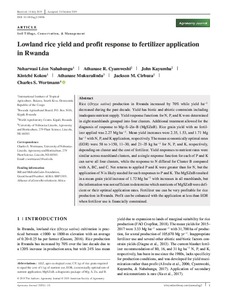| dc.contributor.author | Nabahungu, N.L. |
| dc.contributor.author | Cyamweshi, A.R. |
| dc.contributor.author | Kayumba, J. |
| dc.contributor.author | Kokou, K. |
| dc.contributor.author | Mukuralinda, A. |
| dc.contributor.author | Cirhuza, J.M. |
| dc.contributor.author | Wortmann, C.S. |
| dc.date.accessioned | 2020-08-06T14:25:46Z |
| dc.date.available | 2020-08-06T14:25:46Z |
| dc.date.issued | 2019-12-10 |
| dc.identifier.citation | Nabahungu, N.L., Cyamweshi, A.R., Kayumba, J., Kokou, K., Mukuralinda, A., Cirhuza, J.M. & Wortmann, C.S. (2020). Lowland rice yield and profit response to fertilizer application in Rwanda. Agronomy Journal, 112(2), 1423-1432. |
| dc.identifier.issn | 0002-1962 |
| dc.identifier.uri | https://hdl.handle.net/20.500.12478/6917 |
| dc.description.abstract | Rice (Oryza sativa ) production in Rwanda increased by 70% while yield ha−1 decreased during the past decade. Yield has biotic and abiotic constraints including inadequate nutrient supply. Yield response functions for N, P, and K were determined in eight marshlands grouped into four clusters. Additional treatment allowed for the diagnosis of response to Mg–S–Zn–B (MgSZnB). Rice grain yield with no fertilizer applied was 2.27 Mg ha−1. Mean yield increases were 2.35, 1.53, and 1.71 Mg ha−1 with N, P, and K application, respectively. The mean economically optimal rates (EOR) were 58 to >150, 11–30, and 21–35 kg ha−1 for N, P, and K, respectively, depending on cluster and the cost of fertilizer. Yield responses to nutrient rates were similar across marshland clusters, and a single response function for each of P and K can serve all four clusters, while the response to N differed for Cluster B compared with A, BC, and C. Net returns to applied P and K were greater than for N, but the application of N is likely needed for such responses to P and K. The MgSZnB resulted in a mean grain yield increase of 1.72 Mg ha−1 with increases in all marshlands, but the information was not sufficient to determine which nutrients of MgSZnB were deficient or their optimal application rates. Fertilizer use can be very profitable for rice production in Rwanda. Profit can be enhanced with the application at less than EOR when fertilizer use is financially constrained. |
| dc.description.sponsorship | Bill & Melinda Gates Foundation |
| dc.description.sponsorship | Alliance for a Green Revolution in Africa |
| dc.language.iso | en |
| dc.subject | Oryza Sativa |
| dc.subject | Rwanda |
| dc.subject | Yields |
| dc.subject | Profit |
| dc.subject | Costs |
| dc.subject | Fertilizers |
| dc.subject | Biotic Factors |
| dc.subject | Abiotic Factors |
| dc.title | Lowland rice yield and profit response to fertilizer application in Rwanda |
| dc.type | Journal Article |
| cg.contributor.crp | Roots, Tubers and Bananas |
| cg.contributor.crp | Rice |
| cg.contributor.affiliation | International Institute of Tropical Agriculture |
| cg.contributor.affiliation | Rwanda Agricultural Board |
| cg.contributor.affiliation | World Agroforestry Centre |
| cg.contributor.affiliation | University of Nebraska-Lincoln |
| cg.coverage.region | Africa |
| cg.coverage.region | Central Africa |
| cg.coverage.country | Rwanda |
| cg.coverage.hub | Central Africa Hub |
| cg.researchtheme | Natural Resource Management |
| cg.identifier.bibtexciteid | NABAHUNGU:2020 |
| cg.isijournal | ISI Journal |
| cg.authorship.types | CGIAR and developing country institute |
| cg.iitasubject | Agribusiness |
| cg.iitasubject | Agronomy |
| cg.iitasubject | Farm Management |
| cg.iitasubject | Food Security |
| cg.iitasubject | Integrated Soil Fertility Management |
| cg.iitasubject | Soil Fertility |
| cg.journal | Agronomy Journal |
| cg.notes | Open Access Journal |
| cg.accessibilitystatus | Open Access |
| cg.reviewstatus | Peer Review |
| cg.usagerightslicense | Creative Commons Attribution 4.0 (CC BY 0.0) |
| cg.targetaudience | Scientists |
| cg.identifier.doi | https://dx.doi.org/10.1002/agj2.20006 |
| cg.iitaauthor.identifier | Nsharwasi Nabahungu: 0000-0002-2104-3777 |

